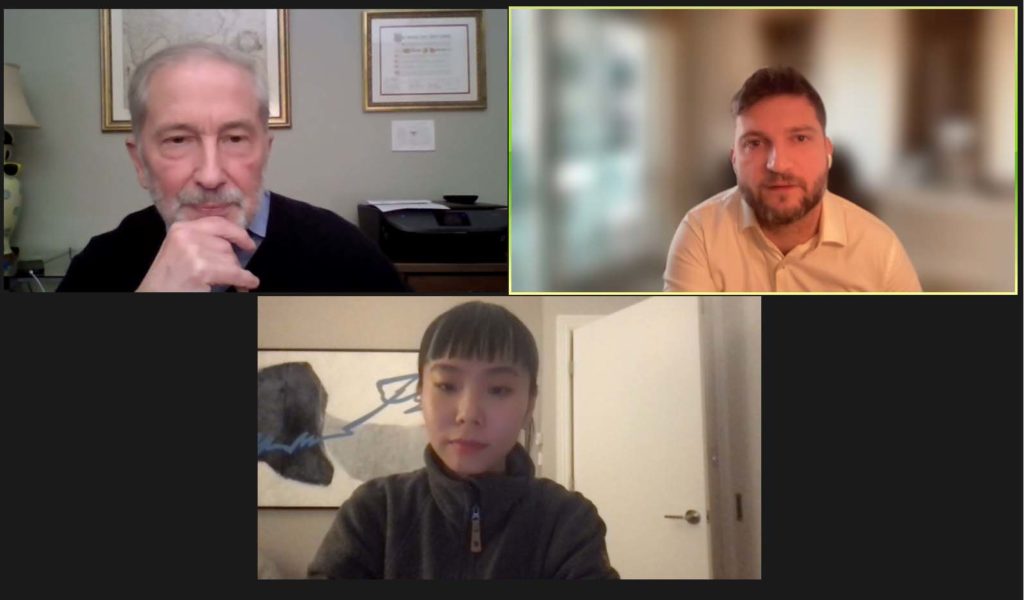Event Coverage Highlight

New York Times Reporters Discuss Covering China’s Expanding Surveillance State in Latest ‘How I Did It’ Program
 by Chad Bouchard
by Chad Bouchard
For New York Times reporters Muyi Xiao and Paul Mozur, the old journalists’ creed “follow the money” bears an update for contemporary times: “follow the data.” Particularly when covering a country like China where on-the-ground coverage is risky and difficult, reporters must rely on data and other digital sources that are accessible from outside the country’s borders, the two said during an OPC program on Nov. 30.
The program, moderated by OPC Past President William J. Holstein, was part of the OPC’s series of “How I Did it” talks with journalists to give behind-the-scenes insight into their reporting. Xiao, who was born and raised in China, started her journalism career working for Reuters and other outlets in China until 2017 when she moved to the U.S. to work for ChinaFile. She is now a reporter and producer on the Times visual investigations team, which combines traditional reporting with advanced digital forensics. Mozur is a correspondent focused on technology and geopolitics in Asia. He was expelled from China in 2020 and is now based in Seoul.
Xiao and Mozur gathered string for two years for their two-part series for the Times, which analyzed a cache of more than 100,000 government bidding documents, with help from ChinaFile, to glean what kinds of domestic surveillance Chinese law enforcement and other agencies are trying to develop, and how those technologies were put to use.
“With very limited ground access, that’s the way we have to go about it nowadays,” Xiao said. “If we had the ground access option that would be more ideal. But thankfully we still have the knowledge of how to navigate China’s internet, and where to find the right information that can help us build our reporting.”
“Getting this data allows us to see exactly what the government wants,” Mozur added. “And allows us to see it in their own words, and to see a frankness from them, because they’re talking to contractors about what they need in a way that you wouldn’t otherwise get.”
The team’s investigation found that the Chinese government, down to the local level, uses technologies such as phone tracking, DNA collection, facial and voice recognition software to gather vast amounts of data. The information is then fed into algorithms to find patterns and predict behavior such as crimes or protests, or, for example, signal police when someone with a history of mental illness approaches a school.
“It’s remarkable. You walk down the street, and the cameras are going to look at who you are,” Mozur said. “You drive down the street, the camera is going to look at your car, it’s going to look for rust stains, it’s going to track your license plates. Your phone is going to connect to these phone trackers, they’re going to try to see what you are running on your phone. They’re going to look for signals both from your wifi as well as your cellular connection.”
He said while most of that information won’t be used, a combination of particular behaviors and information agencies are looking for can trigger alerts. “Once you are on that wrong side of things, it’s like being on a no-fly list from hell. because it’s literally your entire existence. Everything you do is going to kick this up.”
Mozur said government contracts showed how, for example, a police department might ask for a contractor to develop algorithms that compare train ticket purchases with convicted drug users to flag people who have traveled to more than three districts in a day as possible suspects for drug dealing.
“There are actually national competitions between different police departments to come up with clever ideas like that, basically type casting behaviors and saying this is the way we’re going to figure out that someone is selling drugs or going to petition [the government], or whatever.”
One of the stories includes video footage of government officials collecting DNA samples. Holstein asked Xiao how she was able to obtain such video evidence without setting foot inside China.
“One of my jobs every day is just to hunt for videos posted on various corners of the Chinese internet. The kind of content you can see is surprising,” she said. “The government is actually bragging that this is good technology that they are using to help catch criminals better, faster, and to make everyone’s lives safer. So, they’re putting it in local news clips, and then some random people will grab it and upload it to the internet.”
Chinese social media users have become savvy about how to get around censorship on platforms like Weibo or WeChat, by using VPN servers, writing coded texts or confounding software that looks for sensitive content. A program attendee asked about countermeasures Chinese citizens might use to thwart surveillance.
“So far in the country it seems like authorities have better access to these technologies than individuals,” she said. “But maybe more people are [increasing] their awareness of what the government is capable of doing.”
Xiao said people are finding creative ways to dodge censorship systems, but text codes and hiding the location of an internet device is easier than thwarting surveillance cameras and personal data.
Links to the series are below:
Part 1: China’s Surveillance State Is Growing. These Documents Reveal How.
Part 2: ‘An Invisible Cage’: How China Is Policing the Future
Click the window below to watch a playlist of video clips from the program.
Related Events



